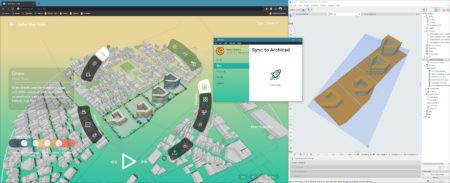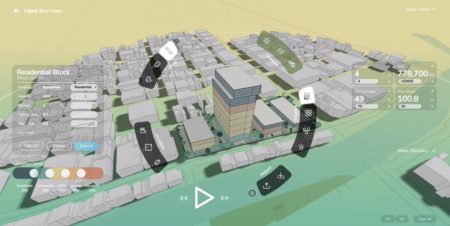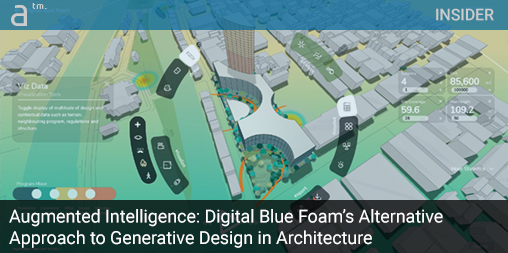DO ARCHITECTS REALLY WANT AI TO GENERATE designs from which to choose from? Digital Blue Foam, a software start-up with a growing global footprint, says the answer is “no.”
In some forms of ‘generative design,’ the process begins with loading in the numerical design criteria (something developers can do). The architects or developers then respond to dozens if not more generated solutions (options really) that can be further manipulated through various software magic, allowing the architect to further fine-tune the results to a ‘Goldilocks’ ideal before shuttling the generated design off to another application—usually a BIM program.
We generate these abstract models, and architects are really good at projecting something into a model that is abstract and seeing possibilities.
This may be a very appealing workflow from the perspective of real estate developers and building asset managers. But architects are hardly rushing to this process. That’s not how architects want to work, says the founders at Digital Blue Foam.
All in a Name
“When we started, we thought we would be focusing on real estate developers,” says cofounder Sayjel Vijay Patel, an MIT-educated architect, and chief technology officer of Digital Blue Foam. “But it is just something about our approach—our company name is Digital Blue Foam—and we understand the design process.” Patel adds, “we generate these abstract models, and architects are really good at projecting something into a model that is abstract and seeing possibilities.”

Digital Blue Foam is web-browser based and offers users a stunning user interface that is both accessible, approachable, and engaging. (Image: Digital Blue Foam / All rights reserved.)
Patel’s double reference refers to the hot-wire cut foam models architecture and planning students learn to make in design schools, often using rigid insulation foam that is often blue. For their generative design solution, the name Digital Blue Foam connotes a deep understanding of how architects and urban planners are trained to think through design problems. “We get it, and this is something that really resonates with architects,” says Patel.
Spacemaker Acquisition
Autodesk announced its USD 240 million acquisition of Spacemaker.ai., a Nordic-based generative design software company with a similar approach to the same core problems in pre-and early-stage building design urban development.
“We were excited when we saw the Spacemaker news,” says Patel, “and it just confirms for us that we are on the right track.” In my recent conversation with Patel, he admitted that “generative design” is a trendy term within architecture today, but he fully believes it will not be a short-term trend. “There is a shift that is going to happen in the way that people are working. And it’s not just going to be one company and one solution that is going to take advantage of this new way of working.”
We are Different
There are currently multiple young software companies solely focused on generative design solutions for pre-design and early-design phase workflows. Most of them are co-led by architects in the software space. What makes Digital Blue Foam different, ultimately, may come down to philosophical orientation rather than specific software technologies. And the origins of this lie with its cofounders.
Patel says that where Digital Blue Foam may stand out the most may come down to a focus on sustainable design. The United Nations has set a hard 2030 target to curb global CO2 emissions to prevent catastrophic climate change. Building construction and operations are responsible for approximately 40-42 percent of total CO2.
“Ultimately, our goal is to build a digital software platform that unites designers, software, and data to accelerate carbon-negative building design, construction, and operations,” says Patel. “We have obsessively designed our UX in Digital Blue Foam to make it easy for architects and urban planners to design sustainable buildings in a few clicks.”
We were excited when we saw the Spacemaker news and it just confirms for us that we are on the right track.
“Digital Blue Foam arose from a desire to rethink workflows in design and architecture,” says Patel. Camiel Weijenberg is the other co-founder and has his own architecture practice in Singapore. Patel says that Weijenberg found it challenging to compete with larger firms to get certain projects, citing the inefficient, traditional processes when responding to proposals and the amount of time needed to turn around concepts.
Summarizing their partnership as a “perfect collaboration,” Digital Blue Foam operated in near stealth mode for nearly three years. “On the one hand, we are very pragmatic, and then from my perspective, I am really pushing on the innovation in terms of design tools, not just from the question of ‘how do we use algorithms’ but what are the user interface and user interaction? How do we make that seamless, and how do we make this a new way of working?”
Beginnings and Agile
The company got its start by developing a generative design solution that Weijenberg’s architecture firm could utilize, and then they started reaching out to other potential customers. They would advance the solution based on feedback and then pitch the refined solution to more firms.

Digital Blue Foam has a Live Sync to GRAPHISOFT’s Archicad and recently has added a Live Sync to Autodesk Revit. Shown above is a synchronization with Archicad. (Image: Digital Blue Foam / All rights reserved.)
“It took us about 2-3 years before we got our first real customer,” he admits. The co-founders were actually not working on Digital Blue Foam full time during their stealth years. Today their team of 15 is scattered around the globe in 8 countries and 4 continents with Weijenberg in Singapore.
It was back at BIMCON in Las Vegas in 2019 that I first saw Digital Blue Foam demonstrated. However, since then, Digital Blue Foam has advanced tremendously in the past two years. There have been more than 3000 signups or trials of the demo software. Their current users are in over 50 countries, with significant users in the United States, Canada, South America, Southeast Asia, Eastern Europe, including places like Russia.
You would be surprised; a lot of their challenges are not just generative design but all the other things around it that make it useful.
Then there is Japan and Korea. “We have a larger enterprise project with Takenaka, which is a major AEC company in Japan, and Space Factory-GG, a Korean company focusing on mass customized residential housing,” says Patel. “So since we launched our collaboration, we have met with their team every week. We present new features, and they give us feedback. We meet with a large group of architects and get additional feedback.” Patel says the company is fully vested in a classic agile development approach to product development. “It is not like we are shooting in the dark,” he adds, “everything we come up with is validated whether it is suitable for the way they work.”
“You would be surprised; a lot of their challenges are not just generative design,” he says, ” but all of the other things around it that make it useful.” Additionally, Digital Blue Foam just formed another collaboration with a large user, the University of Budapest, where a class is being taught based around Digital Blue Foam’s platform. “They are using this in their master’s program in city planning,” adds Patel. “The professors and students see huge potential for the use of technology like this.”
The young software company just opened up an Early Access subscription program. For an individual professional, the Early Access subscription enables architects and planners to test drive Digital Blue Foam for USD 88.00 per month. The company also provides a Teams subscription offering. Enterprises get exclusive features, and the company focused on large enterprises initially as part of a sustainable business model. For example, the push for Live Sync to Archicad came from Takenaka.
Digital Blue Foam
Digital Blue Foam (DBF) is a cloud-based solution that works with a downloaded app, an option to allow a live-streamed connection to Graphisoft’s Archicad and Autodesk Revit. You work entirely through the web browser.

An image of Digital Blue Foam and its Windrose features. Sustainability is the third component of its triad of main features or unique selling point (USP) features. (Image: Digital Blue Foam / All rights reserved.)
Digital Blue Foam has a triad of main features. The first key feature is the Play Button, which generates designs based on inputted criteria. However, one can import a 3D mesh model that forms the limits of the development envelope. The second main feature is the Pen Tool, which differentiates Digital Blue Foam from other similar tools. “You can sketch over the plan, and those sketches will influence what is generated next,” says Patel. “This is how you can get curved shapes—we call it ‘Augmented Intelligence,’ ”
To complete the triad, the third area of the main features focuses on sustainability. It contains a suite of functions, including sun and shadow studies, a heatmap for sunlight averages, and wind-rose data pulled from ten thousand weather stations worldwide. Digital Blue Foam features a small array of data model interoperability, including STL, OBJ, and DXF files. “We are currently working on Rhino and Grasshopper as an additional Live Sync option,” he adds.
Digital Blue Foam has a Live Sync to Graphisoft’s Archicad and more recently, a connection to Autodesk’s Revit. Patel admits they do get asked about Revit more and more and believes this new connection will be a big hit.
But not everyone wants to be a computational designer. And we didn’t want to create a tool that less than one percent of architects can use.
You may be wondering, what about that large Japanese enterprise customer? Well, Takenaka is a key enterprise customer of Graphisoft and is using Archicad, apparently predominantly.
Artificial intelligence (AI) plays a role in generative functions, taking various criteria and using them to generate solutions that meet multiple criteria like FAR or maximum lot coverage ratios and similar kinds of common design challenges for architects.
An Augmented Approach
What Digital Blue Foam is fostering an environment that concentrates on loading in lots of various data like wind, and other kinds of criteria that other solutions, including Spacemaker, are already providing. So far this year, they have established academic collaborations with top researchers from institutions such as Harvard, University of Bern in Switzerland, the University of Belfast, and the National University of Singapore, to focus on different aspects of sustainable design. Patel says that real estate developers are also a tiny percentage of new or potential new users. Still, their solution is much more focused on an augmented approach that encourages the human architect’s engagement in the process via their Pen Tool.

Building blocks can be split (see SplitXY button) and then each separate entity can be assigned a Program category like “Residential” with color-coding and automated area calculations. Furthermore, each split block can be manipulated for setbacks and overhangs allowing some basic modeling manipulation. (Image: Digital Blue Foam / All rights reserved.)
“I studied architecture and then went to MIT for my masters, where I took a lot of classes in urban planning and computer science,” he adds. “But not everyone wants to be a computational designer. And we didn’t want to create a tool that less than one percent of architects can use.”
The Pen Tool features get typical architects engaged in the generative design process, augmenting their intrinsic abilities to see possibilities in 3D models without bogging them down in complex computational criteria.
What may set Digital Blue Foam apart from rival’s tools is this ability to use its Pencil Tool to sketch over solutions and have the system intelligently respond to the input and regenerate its solver algorithm and create new solutions. In this way, the AI and the architect are collaborators in the design process and entwined into a new type of iterative workflow. From this vantage point, architects and planners may find Digital Blue Foam their ideal generative design partner.




Reader Comments
Comments for this story are closed